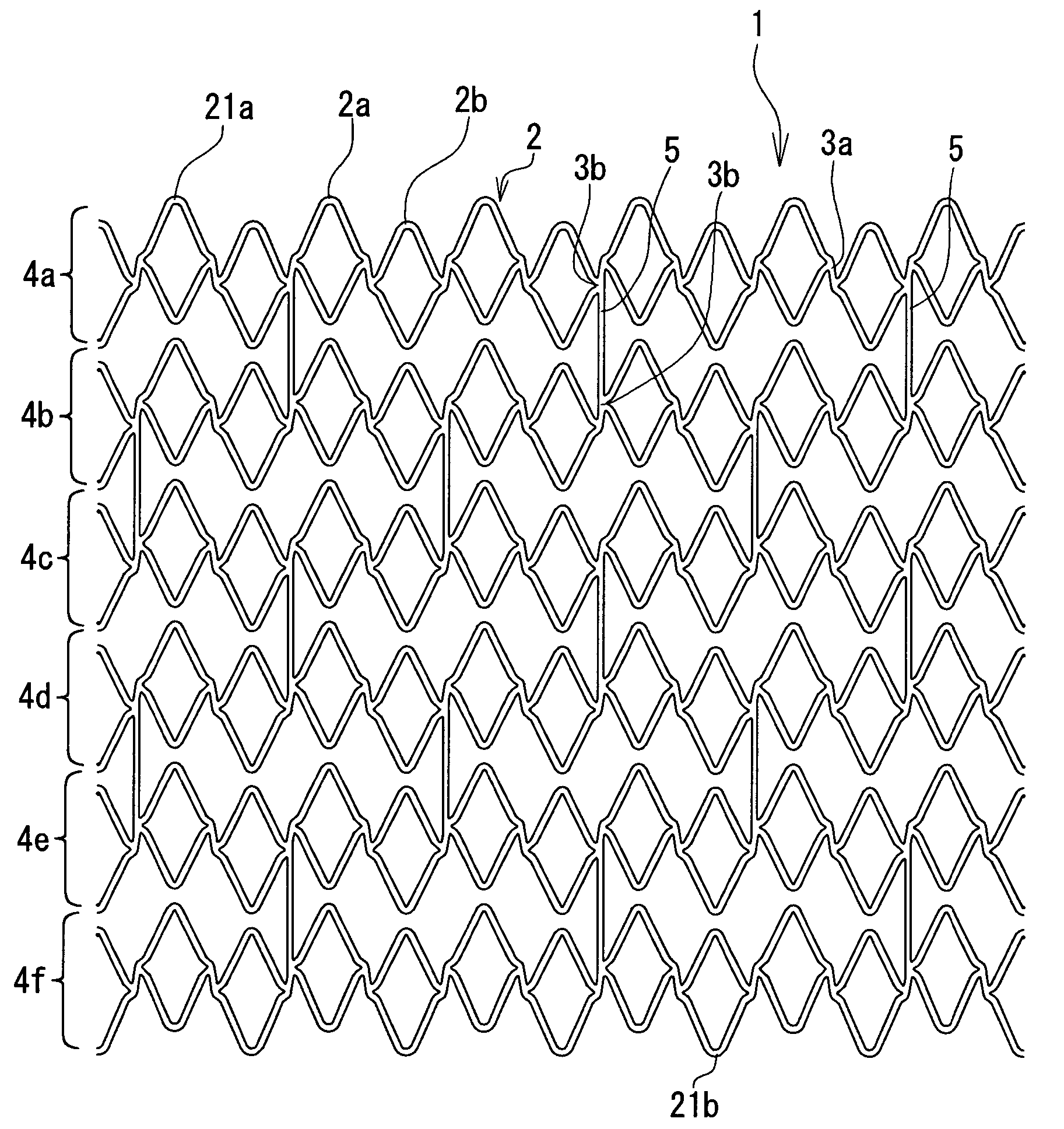Indwelling stent and living organ dilator
a living organ and stent technology, applied in the field of indwelling stents, can solve the problems of limited reduction in diameter by compression, and inability to compress the stent to a sufficiently small diameter, etc., to achieve small change in overall length, excellent shape retention, and reduced diameter
- Summary
- Abstract
- Description
- Claims
- Application Information
AI Technical Summary
Benefits of technology
Problems solved by technology
Method used
Image
Examples
example 1
[0095]A metallic pipe prepared from a stainless steel (SUS316L) pipe having a diameter of 3.0 mm and a material thickness of 0.2 mm by cutting to a length of 18.0 mm was used.
[0096]The stent was produced by blanking the stent portion from the metallic pipe. As the method for blanking the stent from the pipe, a variety of methods may be considered. Examples of the method include an etching method called photo-fabrication in which masking and a chemical agent is used, a discharge machining method using a die, and a mechanical cutting method. Here, a laser machining method which is the simplest and high in machining accuracy was used.
[0097]As a laser machining apparatus, a YAG laser (a product by NEC Corp.; product code: SL116E) was used. The metallic pipe was set on a motored jig equipped with a chuck mechanism so that offset of axis was not generated, and this assembly was set on an XY table capable of numerical control. The XY table and the motor were connected to a personal compute...
example 2
[0103]A stent was produced in the same manner as in Example 1, except that a development of a stent having the form as shown in FIG. 7 was inputted to the personal computer.
[0104]In the stent thus produced, each annular element was roughly rhombic in shape, with a major-axis length of 2.8 mm and a minor axis of 0.5 mm, and 12 annular elements were arranged at substantially regular angular intervals around the stent axis. The length by which the end portions of the adjacent annular elements in the annular unit were staggered from each other in the axial direction (in other words, the length of the axial component between the centers of the adjacent annular elements in the annular unit) was 0.5 mm, the length of the joints 3 extending slantly at a predetermined angle against the stent axis was 0.5 mm, and the length of one annular unit in the axial direction was 3.3 mm. The stent had an overall length of 18.0 mm and an outside diameter of 3.0 mm, comprised six annular units arranged i...
example 3
[0107]A stent was produced in the same manner as in Example 1, except that a development of a stent in the form as shown in FIG. 12 was inputted to the personal computer.
[0108]In the stent thus produced, each annular element was roughly rhombic in shape, with a major-axis length of 2.8 mm and a minor axis of 0.5 mm, and nine annular elements were arranged at substantially regular angular intervals around the stent axis. The length by which the end portions of the adjacent annular elements in the annular unit were staggered from each other in the axial direction (in other words, the length of the axial component of the interval between the centers of the adjacent annular elements in the annular unit) was 0.5 mm, the length of the joints 3 extending substantially in parallel to the stent axis was 0.5 mm, and the length of one annular unit in the axial direction was 3.3 mm. The stent had an overall length of 18.0 mm and an outside diameter of 3.0 mm, and the annular units were linked b...
PUM
 Login to View More
Login to View More Abstract
Description
Claims
Application Information
 Login to View More
Login to View More - R&D
- Intellectual Property
- Life Sciences
- Materials
- Tech Scout
- Unparalleled Data Quality
- Higher Quality Content
- 60% Fewer Hallucinations
Browse by: Latest US Patents, China's latest patents, Technical Efficacy Thesaurus, Application Domain, Technology Topic, Popular Technical Reports.
© 2025 PatSnap. All rights reserved.Legal|Privacy policy|Modern Slavery Act Transparency Statement|Sitemap|About US| Contact US: help@patsnap.com



